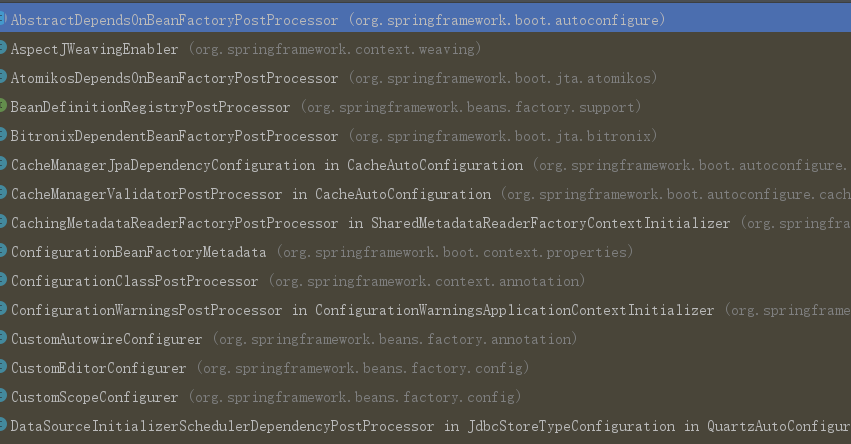Spring扩展点之BeanFactoryPostProcessor
前言
BeanFactoryPostProcessor接口是Spring中一个非常重要的接口,它的接口定义如下
public interface BeanFactoryPostProcessor {
void postProcessBeanFactory(ConfigurableListableBeanFactory beanFactory) throws BeansException;
}
当你实现了这个接口的时候,可以对还没有初始化的bean的属性进行修改或添加
BeanFactoryPostProcessor注册
与BeanPostProcessor的统一注册不同,BeanFactoryPostProcessor的注册是留给具体的业务实现的。它的维护是在AbstractApplicationContext类中
private final List<BeanFactoryPostProcessor> beanFactoryPostProcessors =
new ArrayList<>();
public void addBeanFactoryPostProcessor(BeanFactoryPostProcessor postProcessor) {
Assert.notNull(postProcessor, "BeanFactoryPostProcessor must not be null");
this.beanFactoryPostProcessors.add(postProcessor);
}
执行原理
调用逻辑在AbstractApplicationContext.invokeBeanFactoryPostProcessors方法中
这个方法比较长,可以重点关注我添加注释的地方
protected void invokeBeanFactoryPostProcessors(ConfigurableListableBeanFactory beanFactory) {
PostProcessorRegistrationDelegate.invokeBeanFactoryPostProcessors(beanFactory, getBeanFactoryPostProcessors());
if (beanFactory.getTempClassLoader() == null && beanFactory.containsBean(LOAD_TIME_WEAVER_BEAN_NAME)) {
beanFactory.addBeanPostProcessor(new LoadTimeWeaverAwareProcessor(beanFactory));
beanFactory.setTempClassLoader(new ContextTypeMatchClassLoader(beanFactory.getBeanClassLoader()));
}
}
public static void invokeBeanFactoryPostProcessors(
ConfigurableListableBeanFactory beanFactory, List<BeanFactoryPostProcessor> beanFactoryPostProcessors) {
Set<String> processedBeans = new HashSet<String>();
// 1.判断beanFactory是否为BeanDefinitionRegistry,在这里普通的beanFactory是DefaultListableBeanFactory,而DefaultListableBeanFactory实现了BeanDefinitionRegistry接口,因此这边为true
if (beanFactory instanceof BeanDefinitionRegistry) {
BeanDefinitionRegistry registry = (BeanDefinitionRegistry) beanFactory;
List<BeanFactoryPostProcessor> regularPostProcessors = new LinkedList<BeanFactoryPostProcessor>();
List<BeanDefinitionRegistryPostProcessor> registryProcessors = new LinkedList<BeanDefinitionRegistryPostProcessor>();
// 2.处理入参beanFactoryPostProcessors
for (BeanFactoryPostProcessor postProcessor : beanFactoryPostProcessors) {
if (postProcessor instanceof BeanDefinitionRegistryPostProcessor) {
BeanDefinitionRegistryPostProcessor registryProcessor =
(BeanDefinitionRegistryPostProcessor) postProcessor;
// 如果是BeanDefinitionRegistryPostProcessor则直接执行BeanDefinitionRegistryPostProcessor接口的postProcessBeanDefinitionRegistry方法
registryProcessor.postProcessBeanDefinitionRegistry(registry);
registryProcessors.add(registryProcessor);
} else {
regularPostProcessors.add(postProcessor);
}
}
List<BeanDefinitionRegistryPostProcessor> currentRegistryProcessors = new ArrayList<BeanDefinitionRegistryPostProcessor>();
// 3找出所有实现BeanDefinitionRegistryPostProcessor接口的Bean的beanName
String[] postProcessorNames =
beanFactory.getBeanNamesForType(BeanDefinitionRegistryPostProcessor.class, true, false);
for (String ppName : postProcessorNames) {
// 校验是否实现了PriorityOrdered接口
if (beanFactory.isTypeMatch(ppName, PriorityOrdered.class)) {
// 获取对应的bean实例, 添加到currentRegistryProcessors中,
currentRegistryProcessors.add(beanFactory.getBean(ppName, BeanDefinitionRegistryPostProcessor.class));
processedBeans.add(ppName);
}
}
// 排序(根据是否实现PriorityOrdered、Ordered接口和order值来排序)
sortPostProcessors(currentRegistryProcessors, beanFactory);
registryProcessors.addAll(currentRegistryProcessors);
// 遍历currentRegistryProcessors, 执行postProcessBeanDefinitionRegistry方法
invokeBeanDefinitionRegistryPostProcessors(currentRegistryProcessors, registry);
// 清空currentRegistryProcessors
currentRegistryProcessors.clear();
// 4.与上边3的流程差不多,这是这里处理的是实现Ordered接口
postProcessorNames = beanFactory.getBeanNamesForType(BeanDefinitionRegistryPostProcessor.class, true, false);
for (String ppName : postProcessorNames) {
if (!processedBeans.contains(ppName) && beanFactory.isTypeMatch(ppName, Ordered.class)) {
currentRegistryProcessors.add(beanFactory.getBean(ppName, BeanDefinitionRegistryPostProcessor.class));
processedBeans.add(ppName);
}
}
sortPostProcessors(currentRegistryProcessors, beanFactory);
registryProcessors.addAll(currentRegistryProcessors);
invokeBeanDefinitionRegistryPostProcessors(currentRegistryProcessors, registry);
currentRegistryProcessors.clear();
// 5.调用所有剩下的BeanDefinitionRegistryPostProcessors
boolean reiterate = true;
while (reiterate) {
reiterate = false;
// 找出所有实现BeanDefinitionRegistryPostProcessor接口的类
postProcessorNames = beanFactory.getBeanNamesForType(BeanDefinitionRegistryPostProcessor.class, true, false);
for (String ppName : postProcessorNames) {
// 跳过已经执行过的
if (!processedBeans.contains(ppName)) {
currentRegistryProcessors.add(beanFactory.getBean(ppName, BeanDefinitionRegistryPostProcessor.class));
processedBeans.add(ppName);
reiterate = true;
}
}
sortPostProcessors(currentRegistryProcessors, beanFactory);
registryProcessors.addAll(currentRegistryProcessors);
// 5遍历currentRegistryProcessors, 执行postProcessBeanDefinitionRegistry方法
invokeBeanDefinitionRegistryPostProcessors(currentRegistryProcessors, registry);
currentRegistryProcessors.clear();
}
// 6.调用所有BeanDefinitionRegistryPostProcessor的postProcessBeanFactory方法
invokeBeanFactoryPostProcessors(registryProcessors, beanFactory);
// 7.最后, 调用入参beanFactoryPostProcessors中的普通BeanFactoryPostProcessor的postProcessBeanFactory方法
invokeBeanFactoryPostProcessors(regularPostProcessors, beanFactory);
} else {
invokeBeanFactoryPostProcessors(beanFactoryPostProcessors, beanFactory);
}
// 到这里 , 入参beanFactoryPostProcessors和容器中的所有BeanDefinitionRegistryPostProcessor已经全部处理完毕,
// 下面开始处理容器中的所有BeanFactoryPostProcessor
// Do not initialize FactoryBeans here: We need to leave all regular beans
// uninitialized to let the bean factory post-processors apply to them!
// 8.找出所有实现BeanFactoryPostProcessor接口的类
String[] postProcessorNames =
beanFactory.getBeanNamesForType(BeanFactoryPostProcessor.class, true, false);
// Separate between BeanFactoryPostProcessors that implement PriorityOrdered,
// Ordered, and the rest.
// 用于存放实现了PriorityOrdered接口的BeanFactoryPostProcessor
List<BeanFactoryPostProcessor> priorityOrderedPostProcessors = new ArrayList<BeanFactoryPostProcessor>();
// 用于存放实现了Ordered接口的BeanFactoryPostProcessor的beanName
List<String> orderedPostProcessorNames = new ArrayList<String>();
// 用于存放普通BeanFactoryPostProcessor的beanName
List<String> nonOrderedPostProcessorNames = new ArrayList<String>();
// 8.1 遍历postProcessorNames, 将BeanFactoryPostProcessor按实现PriorityOrdered、实现Ordered接口、普通三种区分开
for (String ppName : postProcessorNames) {
// 8.2 跳过已经执行过的
if (processedBeans.contains(ppName)) {
// skip - already processed in first phase above
} else if (beanFactory.isTypeMatch(ppName, PriorityOrdered.class)) {
// 8.3 添加实现了PriorityOrdered接口的BeanFactoryPostProcessor
priorityOrderedPostProcessors.add(beanFactory.getBean(ppName, BeanFactoryPostProcessor.class));
} else if (beanFactory.isTypeMatch(ppName, Ordered.class)) {
// 8.4 添加实现了Ordered接口的BeanFactoryPostProcessor的beanName
orderedPostProcessorNames.add(ppName);
} else {
// 8.5 添加剩下的普通BeanFactoryPostProcessor的beanName
nonOrderedPostProcessorNames.add(ppName);
}
}
// First, invoke the BeanFactoryPostProcessors that implement PriorityOrdered.
// 9.调用所有实现PriorityOrdered接口的BeanFactoryPostProcessor
// 9.1 对priorityOrderedPostProcessors排序
sortPostProcessors(priorityOrderedPostProcessors, beanFactory);
// 9.2 遍历priorityOrderedPostProcessors, 执行postProcessBeanFactory方法
invokeBeanFactoryPostProcessors(priorityOrderedPostProcessors, beanFactory);
// Next, invoke the BeanFactoryPostProcessors that implement Ordered.
// 10.调用所有实现Ordered接口的BeanFactoryPostProcessor
List<BeanFactoryPostProcessor> orderedPostProcessors = new ArrayList<BeanFactoryPostProcessor>();
for (String postProcessorName : orderedPostProcessorNames) {
// 10.1 获取postProcessorName对应的bean实例, 添加到orderedPostProcessors, 准备执行
orderedPostProcessors.add(beanFactory.getBean(postProcessorName, BeanFactoryPostProcessor.class));
}
// 10.2 对orderedPostProcessors排序
sortPostProcessors(orderedPostProcessors, beanFactory);
// 10.3 遍历orderedPostProcessors, 执行postProcessBeanFactory方法
invokeBeanFactoryPostProcessors(orderedPostProcessors, beanFactory);
// Finally, invoke all other BeanFactoryPostProcessors.
// 11.调用所有剩下的BeanFactoryPostProcessor
List<BeanFactoryPostProcessor> nonOrderedPostProcessors = new ArrayList<BeanFactoryPostProcessor>();
for (String postProcessorName : nonOrderedPostProcessorNames) {
// 11.1 获取postProcessorName对应的bean实例, 添加到nonOrderedPostProcessors, 准备执行
nonOrderedPostProcessors.add(beanFactory.getBean(postProcessorName, BeanFactoryPostProcessor.class));
}
// 11.2 遍历nonOrderedPostProcessors, 执行postProcessBeanFactory方法
invokeBeanFactoryPostProcessors(nonOrderedPostProcessors, beanFactory);
// Clear cached merged bean definitions since the post-processors might have
// modified the original metadata, e.g. replacing placeholders in values...
// 12.清除元数据缓存(mergedBeanDefinitions、allBeanNamesByType、singletonBeanNamesByType),
// 因为后处理器可能已经修改了原始元数据,例如, 替换值中的占位符...
beanFactory.clearMetadataCache();
}
细心的同学可能会发现上方还出现了一个BeanDefinitionRegistryPostProcessor,这个东东其实是BeanFactoryPostProcessor的特殊实习,观察调用它的方法可以看到它需要一个参数:BeanDefinitionRegistry,通过这个参数可以更为方便的去做一些自定义bean的操作
总结一下上方的逻辑:
- 将
BeanFactoryPostProcessor和BeanDefinitionRegistryPostProcessor,分别放入两个集合 - 分别进行排序处理
- 按照优先级分别调用
invokeBeanDefinitionRegistryPostProcessors和invokeBeanFactoryPostProcessors方法 - 这两个invoke方法相信你可以想象的到无非就是循环调用这些实现类对应的方法
Spring的实现
查看这个接口的继承体系,可以看到这个接口的实现类是非常多的,各个实现类的功能如果感兴趣大家可以去慢慢挖掘一下

Spring扩展点之BeanFactoryPostProcessor的更多相关文章
- Spring扩展点之Aware接口族
引言 Spring中提供了各种Aware接口,方便从上下文中获取当前的运行环境,比较常见的几个子接口有:BeanFactoryAware,BeanNameAware,ApplicationContex ...
- Spring扩展点-v5.3.9
Spring 扩展点 **本人博客网站 **IT小神 www.itxiaoshen.com 官网地址****:https://spring.io/projects/spring-framework T ...
- Spring扩展点之BeanPostProcessor
前言 BeanPostProcessor接口是Spring中一个非常重要的接口,它的接口定义如下 public interface BeanPostProcessor { Object postPro ...
- Spring扩展点之FactoryBean接口
前言 首先看一下接口定义 public interface FactoryBean<T> { /** * 返回对象实例 */ @Nullable T getObject() throws ...
- spring扩展点之PropertyPlaceholderConfigurer
原理机制讲解 https://leokongwq.github.io/2016/12/28/spring-PropertyPlaceholderConfigurer.html 使用时多个配置讲解 ht ...
- Spring-IOC 扩展点 BeanFactoryPostProcessor及其子接口解析
BeanFactoryPostProcessor 接口的英文描述: Allows for custom modification of an application context's bean de ...
- Spring中的扩展点
Spring作为一个常用的IOC框架,在设计上预留了很多的扩展点,很多第三方开源框架,包括Spring自身也是基于这些扩展点实现的,这很好的体现了对修改关闭.对扩展开放的原则.总的来说Spring的扩 ...
- Spring源码系列 — BeanDefinition扩展点
前言 前文介绍了Spring Bean的生命周期,也算是XML IOC系列的完结.但是Spring的博大精深,还有很多盲点需要摸索.整合前面的系列文章,从Resource到BeanDefinition ...
- Spring系列14:IoC容器的扩展点
Spring系列14:IoC容器的扩展点 回顾 知识需要成体系地学习,本系列文章前后有关联,建议按照顺序阅读.上一篇我们详细介绍了Spring Bean的生命周期和丰富的扩展点,没有阅读的强烈建议先阅 ...
随机推荐
- uwsgi + nginx 发布
下载uwsgi 基于pip 若是没有下载 yum install -y python2-pip pip install uwsgi 出上面的错 ,安装python的development包 yum i ...
- lf 前后端分离 (3) 中间建跨域
一.关于中间建跨域 为了减少跨域代码冗余,采用中间件 from django.utils.deprecation import MiddlewareMixin class CorsMiddleware ...
- E04 【买衣服】Do you have this T-shirt in red?
核心句型 Do you have this T-shirt in red? 这样的T恤衫,你们有红色的吗? 场景对话: A:Excuse me,do you have this T-shirt in ...
- python3汉诺塔简单实现代码
小时候喜欢玩汉诺塔,今天用python实现简单的汉诺塔功能 代码: def hannoi(n,x,y,z): if n==1: print(x,'-->',z) else: hannoi(n-1 ...
- Genymotion模拟器上money测试
1.查看APK包名:sdk\build-tools\android-4.4W>aapt dump xmltree 123.apk AndroidManifest.xml 查看包名为:com.aa ...
- DLinNLP
2015蒙特利尔深度学习暑期学校之自然语言处理篇 用户1737318 8月3日至8月12日在蒙特利尔举办的深度学习署期学校中,来自不同领域的深度学习顶尖学者 (Yoshua Bengio, Leon ...
- Jmeter压力并发测试
一.http://jmeter.apache.org/ 二.点击Download Releases选择版本下载 三.下载解压: 将解压后的文档存盘-下载logkit-2.0.jar(汉化包)放到jme ...
- spring讲解
今日先简单介绍一下Spring bean 的 5 种效果域,然后详细介绍 singleton 和 prototype 这两种最常用的效果域. JavaSpring Bean的五种效果域 效果域的种类 ...
- cookie清除及其他操作
JavaScript是运行在客户端的脚本,因此一般是不能够设置Session的,因为Session是运行在服务器端的. 而cookie是运行在客户端的,所以可以用JS来设置cookie. 一:设置co ...
- 微信小程序之页面打开数量限制
无论是在小程序还是APP中,打开一个页面其实就是创建了一个新的View对象,一层层叠加的.当点击页面的回退按钮就是把当前页面关闭. 这个过程中会涉及到一个问题,就是打开页面的数量.在某些设计下,比如一 ...
